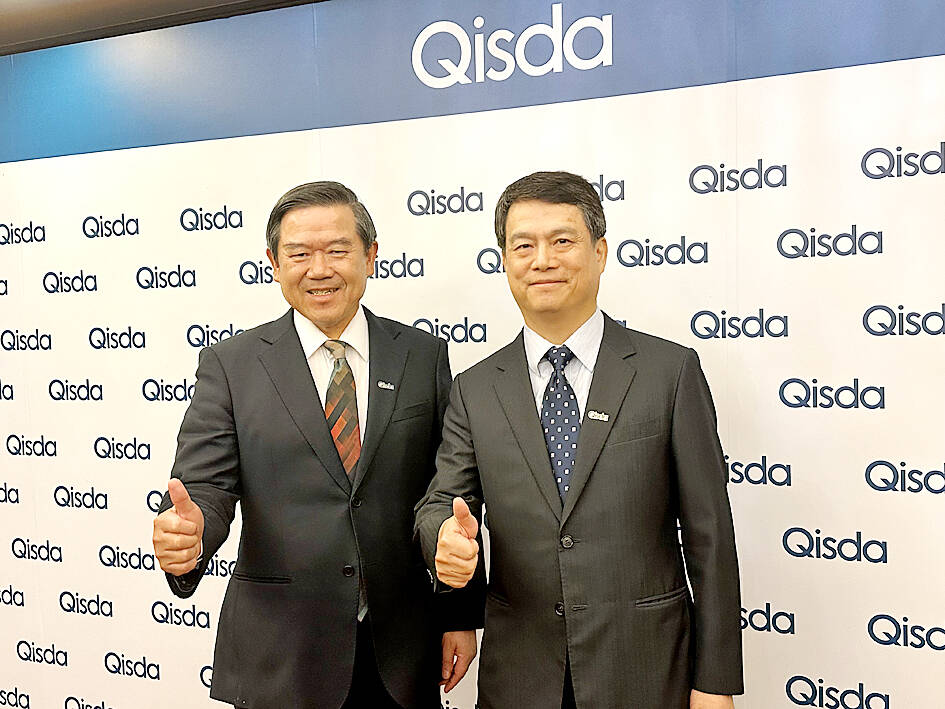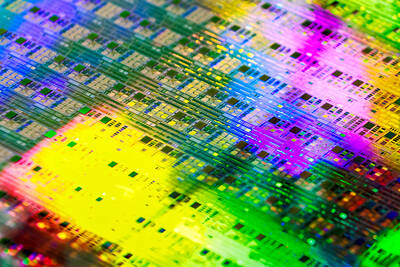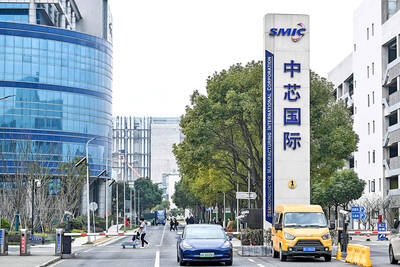Liquid-crystal display and projector manufacturer Qisda Co (佳世達) yesterday said second-quarter revenue is expected to be better than the first quarter, which rose 6 percent year-on-year to NT$49.75 billion (US$1.64 billion).
However, the outlook remains uncertain, as shipments could be affected by the outcome of US trade talks, the end of the 90-day tariff pause on July 8, a stronger New Taiwan dollar and geopolitical tensions such as tensions between India and Pakistan, Qisda chairman Peter Chen (陳其宏) said at an online earnings conference.
“We will strive to maintain the revenue growth in the second quarter,” Chen said.

Photo: Chen Mei-ying, Taipei Times
Regarding the potential impact of US tariff uncertainty, Qisda president Joe Huang (黃漢州) said the company is considering building new factories in countries with lower US tariffs such as Mexico, and might relocate its artificial intelligence or industrial production lines to the US.
Qisda has small processing plants in California and would use them as a base to expand local operations, Huang said, adding that the company might seek another site if orders exceed the existing plants’ capacity.
To cope with the recent NT dollar surge, the company is adopting a natural hedging strategy to ease potential risks, while using foreign exchange forward contracts as alternative buffers, Qisda chief financial officer Jasmin Hung (洪秋金) said.
The rapid appreciation of the NT dollar is likely to affect revenue in key business sectors in the coming months, but at the same time some of the company’s more than 200 global operations using various currencies could benefit from the currency fluctuations, she said.
Qisda’s net profit in the first quarter reached NT$594 million, up 50 percent from a year earlier, with earnings per share at NT$0.25.
Gross margin rose 1.3 percentage points year-on-year to 17.3 percent — its highest ever — driven by optimized product and business mix, while operating margin was flat at 2 percent, the company said.
By sector, information and communications technology (ICT) revenue rose 7 percent year-on-year to NT$27 billion in the first quarter, followed by business solutions at NT$8.1 billion, medical applications at NT$7.2 billion, networking and communications business at NT$4.5 billion, and others at NT$3 billion, Qisda said.
The medical sector showed strong growth potential, accounting for 14 percent of total revenue and ranking second among the company’s high-value-added sectors, while networking and communications contributed only 9 percent due to industry contraction, Chen said.
The medical sector would be Qisda’s main growth driver this year, and the company plans to expand its investments in the field to differentiate itself from other ICT rivals, he said.
Revenue from the US accounted for 26 percent of Qisda’s total, but just 1 percent of its medical sector revenue, leaving room to adjust its strategy for revenue and profit growth in the coming quarters as the sector is less affected by tariff uncertainty, he said.

NO BREAKTHROUGH? More substantial ‘deliverables,’ such as tariff reductions, would likely be saved for a meeting between Trump and Xi later this year, a trade expert said China launched two probes targeting the US semiconductor sector on Saturday ahead of talks between the two nations in Spain this week on trade, national security and the ownership of social media platform TikTok. China’s Ministry of Commerce announced an anti-dumping investigation into certain analog integrated circuits (ICs) imported from the US. The investigation is to target some commodity interface ICs and gate driver ICs, which are commonly made by US companies such as Texas Instruments Inc and ON Semiconductor Corp. The ministry also announced an anti-discrimination probe into US measures against China’s chip sector. US measures such as export curbs and tariffs

The US on Friday penalized two Chinese firms that acquired US chipmaking equipment for China’s top chipmaker, Semiconductor Manufacturing International Corp (SMIC, 中芯國際), including them among 32 entities that were added to the US Department of Commerce’s restricted trade list, a US government posting showed. Twenty-three of the 32 are in China. GMC Semiconductor Technology (Wuxi) Co (吉姆西半導體科技) and Jicun Semiconductor Technology (Shanghai) Co (吉存半導體科技) were placed on the list, formally known as the Entity List, for acquiring equipment for SMIC Northern Integrated Circuit Manufacturing (Beijing) Corp (中芯北方積體電路) and Semiconductor Manufacturing International (Beijing) Corp (中芯北京), the US Federal Register posting said. The

India’s ban of online money-based games could drive addicts to unregulated apps and offshore platforms that pose new financial and social risks, fantasy-sports gaming experts say. Indian Prime Minister Narendra Modi’s government banned real-money online games late last month, citing financial losses and addiction, leading to a shutdown of many apps offering paid fantasy cricket, rummy and poker games. “Many will move to offshore platforms, because of the addictive nature — they will find alternate means to get that dopamine hit,” said Viren Hemrajani, a Mumbai-based fantasy cricket analyst. “It [also] leads to fraud and scams, because everything is now

MORTGAGE WORRIES: About 34% of respondents to a survey said they would approach multiple lenders to pay for a home, while 29.2% said they would ask family for help New housing projects in Taiwan’s six special municipalities, as well as Hsinchu city and county, are projected to total NT$710.65 billion (US$23.61 billion) in the upcoming fall sales season, a record 30 percent decrease from a year earlier, as tighter mortgage rules prompt developers to pull back, property listing platform 591.com (591新建案) said yesterday. The number of projects has also fallen to 312, a more than 20 percent decrease year-on-year, underscoring weakening sentiment and momentum amid lingering policy and financing headwinds. New Taipei City and Taoyuan bucked the downturn in project value, while Taipei, Hsinchu city and county, Taichung, Tainan and Kaohsiung